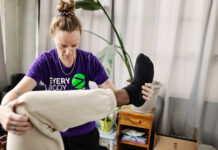
Each year more than 50 per cent of runners are sidelined with an injury. When it comes to running injuries, debate often circulates around footwear and biomechanics as the culprits. Let’s be real: 80 per cent of running injuries are due to training errors.
1Switch Up the Pace
If you are running at the same pace for all your runs, you will be stressing your joints, muscles, and tendons in the same repetitive manner, increasing your risk of injury. Remember that each run has a specific purpose. Including hills, speed intervals and even track sessions in your training program is not only an important way to increase your fitness, but also for varying the repetitive stress of running.
2Run More Frequently
it may seem counterintuitive, but running more frequently with a slightly shorter average distance, can be an effective way to increase your running fitness and minimize your injury risk. Too often there is a boom and bust scenario where runners push too hard after seeing an increase in fitness which can lead to an overuse injury unless there is adequate recovery time. Running more frequently can effectively stimulate soft tissue adaptations while mitigating the boom and bust cycle.
3Be Aware of Persistent Niggles
Do not ignore any aches or niggles particularly if they persist over several runs. Trying to run through ongoing pain can lead to movement compensations and secondary injury. A running assessment from an astute professional can help identify what’s causing your overuse injuries and help improve your running performance.
4Seek Help Before Injuries Arise
Seeking help can involve getting a training program designed by an experienced running coach or seeing a healthcare professional such as a physiotherapist, chiropractor or massage therapist to help manage an existing issue. Running injuries are often multi-faceted and complex which make them challenging to manage. A running gait assessment performed by a qualified professional (who is also a runner) is an excellent way to gain valuable insight into your training methods and running biomechanics.
5Prioritize Recovery & Cross-Training
Your success with a running program, or any fitness program, is determined by your body’s ability to adapt to the stress of the activity. Adequate recovery means ensuring you’re getting 7-9 hours of sleep per night, staying hydrated, eating a balanced diet and cross-training. Swimming, biking, elliptical and deep water running can further stimulate the aerobic system while reducing stress on weight-bearing joints, tendons and muscles.
While running can be an injurious activity, it does not have to be. By practicing sound training principles, listening to your body, knowing the warning signals for injuries and when to seek help, you can help keep yourself injury-free in the long run.
















